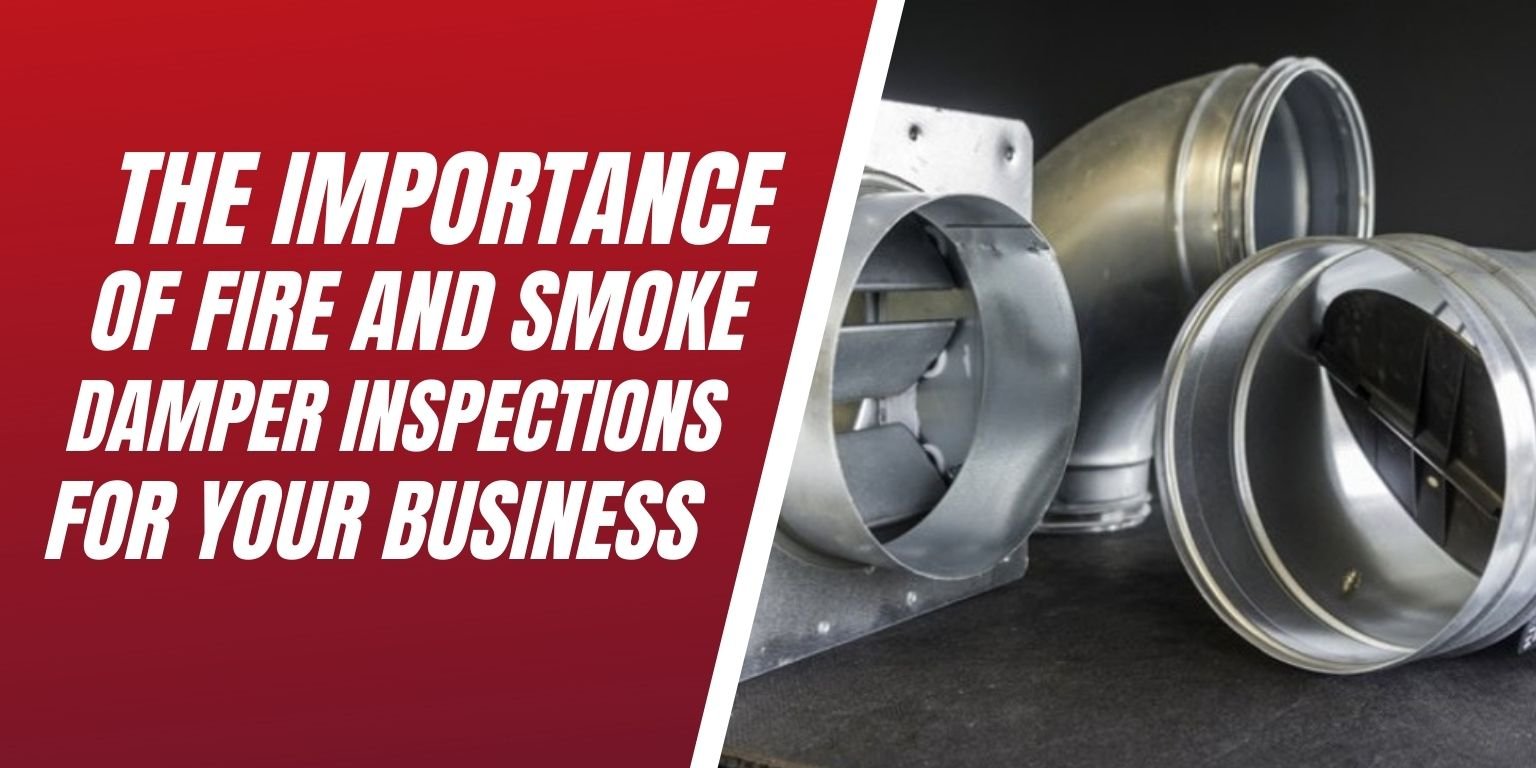
Thanksgiving is next week, which means the holidays are right around the corner! December is one of the busiest times of the year for many people. But as festive as all the lights and decorations are, according to the National Fire Protection Association (NFPA) there is a higher chance for fires to start during the holidays.
As a facility manager, ensuring that your facility’s fire and life safety systems are properly maintained is just one of the many parts of your job. One of the most important parts of your building’s fire and life safety protection systems are fire and smoke dampers. It may not seem like a big deal, but both fire and smoke can spread fast! Unfortunately, the ventilation system is one of the best ways for a fire to quickly take over a facility because it is hidden and connects to multiple rooms throughout the building. Since dampers are installed in the ductwork, it’s easy to forget they are there and they may go too long without being inspected.
According NFPA 80 (fire dampers) and 105 (smoke dampers), “dampers should be tested and inspected every four years in non-healthcare facilities, and every six years in healthcare facilities”.
Why are Fire Damper Inspection Services Important?
Healthcare Facilities
Healthcare facilities are “Defend in Place” facilities. So, in the event of a fire, patients who may be tied to life support machines or going through an operation would not be able to evacuate. In fact, many patients in hospitals, as well as nursing homes, are unable to be moved or are too sick to move quickly enough to escape danger during a fire. To combat this, compartmentalizing your facility helps prevent the spread of flames and smoke, while also protecting those who have little to no mobility.
Dampers will help to prevent the spread of fire and smoke from one location of a healthcare facility to another through the duct. This will allow for those who are difficult to move time to evacuate or for those who can’t not be moved to safety stay in their room while waiting for first responders.
Educational Campuses
Every year, colleges and universities are responsible for providing their students with the resources to better their education as well as providing their students with a safe learning environment. Fire and life safety preparedness is crucial not only to its occupants, but also to the parents who have entrusted facility personnel to maintain the safety of their students. As a facility manager, you have a lot of ground to cover with dozens of classrooms, administrative, recreational, and residential buildings on your campus.
By installing dampers in each building on campus, they will help contain both fire and smoke to one location of a building and potentially catching other buildings near on fire. This will greatly lower unnecessary property damage, while also keeping everyone on your campus safe.
Commercial Facilities
Commercial facilities tend to get all kinds of people traffic. Whether it’s in a high-rise office building full of offices or a hotel full of people who come and go, especially now with the holiday season coming up. This means many people will be on the road traveling to spend time with their families and loved ones. Hotels, restaurants and tourist attractions will be busy with people coming and going through the New Year. And with so many people on the property, risks of a fire can increase during this time of the year. Every type of commercial faces its own challenges when it comes to fire protection, prevention, and guests’ safety.
It only takes about 30 seconds for a small flame to grow and become a major fire, and smoke can travel 120 – 420 feet per minute under fire conditions. This allows hallways and stairwells to become dark and hard to navigate. So, those in high rise buildings would ultimately put in danger right away. But dampers will allow those time to quickly and safely evacuate, but cutting off fire and smoke from spreading through the vents.
Therefore, one of the best compartmentalizing tools you can use in your facility, no matter what industry, are dampers. There are three types of dampers, fire, smoke, and combination. However, do you know how each damper works to help keep your facility and its occupants safe during a fire?
1. Fire Dampers
In general, a fire damper works when the heat from the fire causes the normal temperature of a room to rise to about 165 degrees Fahrenheit. The fusible link attached to the damper would then melt, causing the damper’s door to close. In rooms where the normal temperature of the room is consistently higher, a higher degree fusible link would be attached to the damper. These particular fusible links would melt at a temperature about 212 Fahrenheit. There are two types of fire damper designs used to help prevent the spread of flames, a dynamic fire damper and a static fire damper.
- Dynamic fire dampers are located in vertical barriers, where the HVAC system fan will stay on in the event of a fire. Because they are installed in vertical barriers, these particular fire dampers have a spring-loaded design. The spring-loaded design is where the doors of the damper have a spring like action when they are forced to shut. Since the HVAC system fan will remain on, the air pressure from the fan will help the doors of the damper to spring shut.
- Static fire dampers are located in barriers where the HVAC system fan will shut off in the event of a fire. These particular fire dampers would be installed in horizontal barriers, and would have a curtain like design. Since the HVAC system fan will turn off, there would be no air pressure and the door of the damper will fall due to gravity.
To learn more about the differences between dynamic and static fire dampers, Click Here.
2. Smoke Dampers
On the other hand, smoke dampers resist the passage of air and smoke within the ductwork. They are typically operated by a smoke detector, which would also be located in the duct. Once smoke has been detected, the smoke detector sends a signal to the damper’s actuator, which uses the jackshaft and linkage to open and close the blades of the smoke damper. There are two types of actuators:
- Pneumatic actuators use air pressure to function properly. When enough pressure has built up in contrast to the outside air pressure, it results in the controlled movement of a device such as a gear. This resulting movement can be directed in either a straight line or circular motion. There are two primary varieties of pneumatic linear actuators: single-acting and double-acting.
Why use a pneumatic actuator? Pneumatic actuators have a pretty low initial costs than that of other types of actuators. Their speed and thrust are positively linked, meaning as one increase, the other does as well. However, these particular actuators are better for industries that need force, electric actuators provide more accurate control and positioning.
- Electric actuators use electric power to function properly. These actuators are made up of a screw, coupler and motor, such as a stepper or servo. The screw turns and moves a nut, which makes the connecting rod or carriage shift the load.
Why choose electric actuators? Where pneumatic actuators are better for industries that need force, electric actuators provide more accurate control and positioning. The standard models of the electric variety can move with precision from hundredths to thousandths of an inch. These actuators also produce less noise than other types, making electric models very useful in noise-sensitive environments.
For more information about the differences between pneumatic and electric actuators, Click Here.
3. Combination Dampers
Lastly, combination dampers, which are both a fire and a smoke damper in one, are used in areas of the ductwork where both fire and smoke barriers are located to prevent the spread of both fire and smoke.
Damper Repairs
NFPA 80 and 105 state, “If the damper is not operable, repairs shall begin as soon as possible."
According to inspections that Life Safety Services® preforms, approximately 22% of dampers fail their inspection. Out of facilities that are not regularly inspected, 35% of dampers fail their inspection.
That’s a lot, especially for a fire protection system that it so important to the safety of your building’s occupant’s during the event of a fire. This is why we believe knowing how each type of damper is designed and works; can help you have a better understanding of the importance of your facility’s fire and smoke damper inspections and repairs. Where your building is a healthcare facility, educational campus, or commercial facility it doesn’t take long for a small fire to become out of control and completely engulf a building in flames. As terrifying as that is, smoke inhalation is the leading cause of death in a fire, because it can travel quickly filling up any hallway or stairwell. By cutting off the passageways for both fire and smoke to travel, the fire will be contained to one specific location.
For more information about how fire and smoke damper inspections and repairs, Contact Us Here or call 888-675-4519 to find out how we can help keep your facility’s dampers in compliance with the codes and standards!

